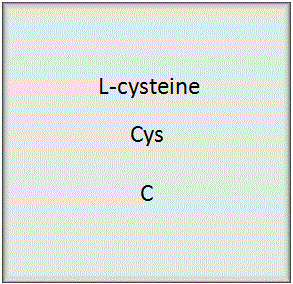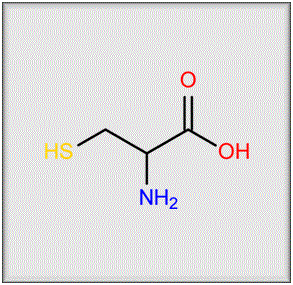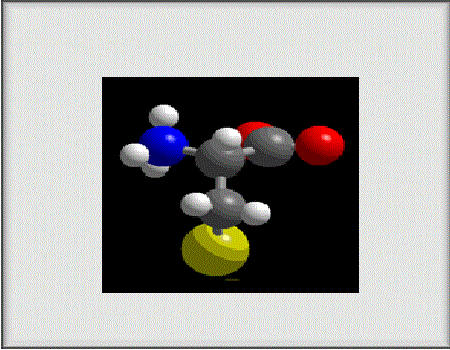AMINO ACID BIOSYNTHESIS: FORMATION OF L-CYSTEINE
The amino acid L-cysteine is synthesized by a simple two step pathway using L-serine as the starting molecule. Although it is unknown if L-cysteine is acquired from the cell surroundings, cells do uptake precursors to conserve carbon and energy for use in other cell pathways.
The overall L-cysteine biosynthesis pathway formula is:
L-serine + acetyl-CoA + H2S → L-cysteine + CoA + acetate + H+

Key Concepts
- E. coli synthesizes L-cysteine in two steps starting with L-serine.
- This pathway requires a supply of sulfur atoms in the form of sulfide.
- E. coli cells import pathway precursors when available.
- As a low abundance amino acid present in proteins, cells do not require synthesis of large amounts of L-cysteine for cell growth.
Operation of the L-Cysteine Biosynthesis Pathway
E. coli cells require less L-cysteine for cell growth than many other amino acids since this sulfur containing amino acid constitutes about 1.5 % of the total amino acids content of proteins. However, L-cysteine also serves as the sulfur donor for the synthesis of other cellular molecules such as L-methionine, glutathione, coenzyme A and molybdenum cofactor.
I. The pathway for L-cysteine synthesis from L-serine
This simple two step biosynthetic pathway depends on the ability of E. coli to either synthesize or accumulate the pathway precursor, L-serine.
Serine acetyltransferase(CysE)
In this energy consuming step acetyl-CoA serves as an acetyl donor to activate L-serine to give O-acetyl-L-serine. O-acetyl-L-serine formation is strongly inhibited by L-cysteine binding to the serine binding site.
L-serine + acetyl-CoA → O-acetyl-L-serine + coenzyme A
Cysteine synthase (CysM or CysK)
Following activation of L-serine to O-acetyl-L-serine, a molecule of sulfur is introduced onto the carbon backbone to form L-cysteine plus acetate. Hydrogen sulfide is the suflur donor. Two isoenzymes encoded by cysM or cysK can catalyze this reaction.
O-acetyl-L-serine + H2S → L-cysteine + acetate + H+
II. Uptake of L-cysteine across the cell membrane
Little is known about the ability of E. coli to uptake L-cysteine from the cell surroundings. However, the precursor of the L-cysteine biosynthesis pathway, L-serine, can be acquired by one of three different transport systems.
See More
The serine:H+ symporter (SdaC) employs the H+ gradient to import L-serine. The serine/threonine:H+ symporter (TdcC) is a threonine transporter that also imports L-serine using the H+ gradient. The serine/threonine:Na+ symporter (SstT) imports both L-serine and L-threonine with a Na+ gradient in place of the more commonly used H+gradient. The TdcC and SdaC transporters are more likely to be used when E. coli grows with serine as a nutrient.
III. Regulation of L-serine biosynthesis and transport
E. coli cells are economical in conserving carbon molecules and energy. Control of L-cysteine biosynthesis occurs by a regulating gene expression and protein activity. An overview is provided below.
Transcriptional control by repression
The CysB protein serves as a positive regulator (i.e., activator) of cysKgene transcription. This same regulator is involved in control of several other E. coli genes used for sulfur acquisition and processing in the cell.
Translational control by small RNAs
The small regulatory RNA named RyhB is known to regulate iron homeostasis, however, it also suppresses translation of the cysE mRNA. Few details are available about the mechanism of this control.
Allosteric enzyme control by feedback inhibition
The pathway end product L-cysteine functions as a feedback signal to control enzyme activity. When L-cysteine levels are high and additional L-cysteine synthesis would be wasteful of cell resources, it binds to the first pathway enzyme and inhibits serine acetyltransferase catalytic activity. If L-cysteine levels drop in the cell due to protein synthesis, serine acetyltransferase activity is restored.
Summary
- E. coli cells synthesize L-cysteine using a simple two step pathway.
- L-serine, the starting molecule for the pathway, is either acquired from the cell surroundings or made from other cell precursors.
- Acetyl-CoA is used to activate the L-serine to prepare it for incorporation of an atom of sulfur.
Credits:
Authored by Robert Gunsalus and Imke Schröder
©The Escherichia coli Student Portal
This project acknowledges support from:
NIH Grant Award GM077678 to SRI, International
Peter Karp and coworkers at EcoCyc.org
The UCLA Department of MIMG


